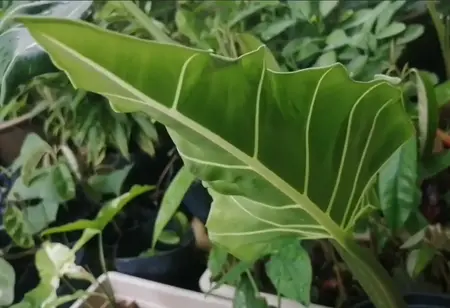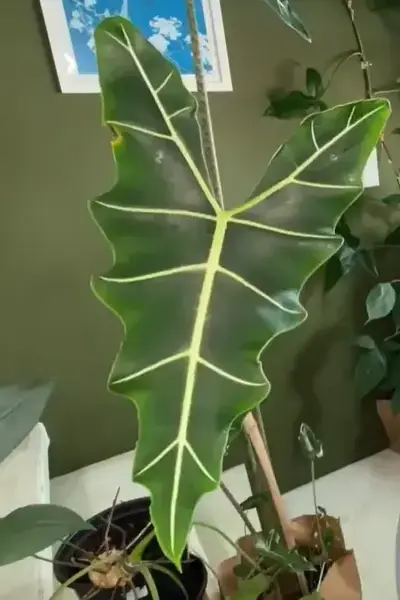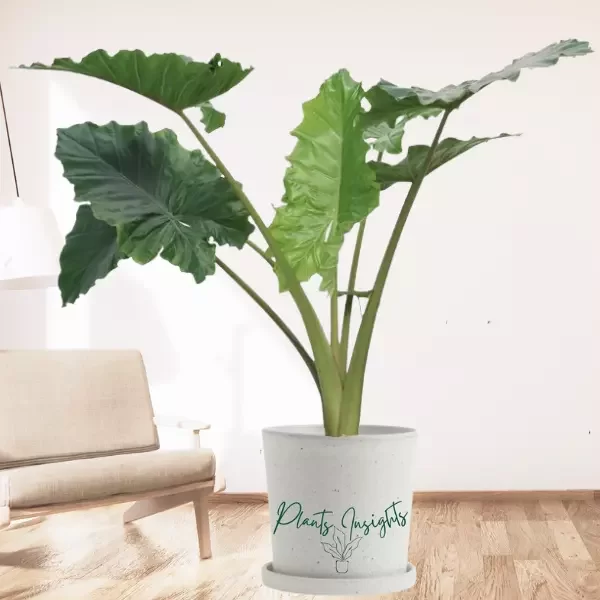Alocasia Sarian is an amazing looking popular indoor houseplants from the Alocasia genus and is often called Elephant’s Ear. Alocasia Sariana originates from the tropical regions of South Asia. Plants belonging to the genus Alocasia are perennial, flowering, rhizomatous, or tuberous plants in the family Araceae. It’s a hybrid of the Zebrina and Micholitziana Alocasias featuring ginormous deep green pointed leaves. This plant has a beautiful, exotic look and grows exceptionally well in containers.
As it grows, the stem will become thicker and bushier, so you will want to plant it in a container that provides good support. Branches of this plant can reach 6 feet in height, and leaves are 2 to 6 inches wide. The leaves have a thick waxy texture, making them ideal for displaying in a hanging basket. Alocasia Sarian is classified as a flowering plant. It produces large blooms similar o Calla Lily flowers; however, it is rare to see the plant blooming outside its natural habitat.
Allied Species: Alocasia Silver Dragon, Alocasia Lauterbachiana, Alocasia Pink Dragon, Alocasia Dark Star, Alocasia Portora, Alocasia Cucullata, Alocasia Cuprea, Alocasia Maharani, Alocasia Azlanii.
Related Products:
Habitat & Ecology
| Botanical Name: | Alocasia “Sarian” |
| Family Name: | Araceae |
| Common names: | Elephant’s ear, African mask, Green Velvet Alocasia |
| Plant type: | Tropical flowering perennial plant |
| Origin: | Native to the Philippines |
| Bloom: | White |
| Height: | 5.00 to 10.00 feet |
| Humidity: | 60%-70%. |
| Temperature: | 65°F-72°F (18 to 22 degrees Celsius) |
| Light Need | Bright, indirect light |
How Do You Take Care of Alocasia Sarian Plant?
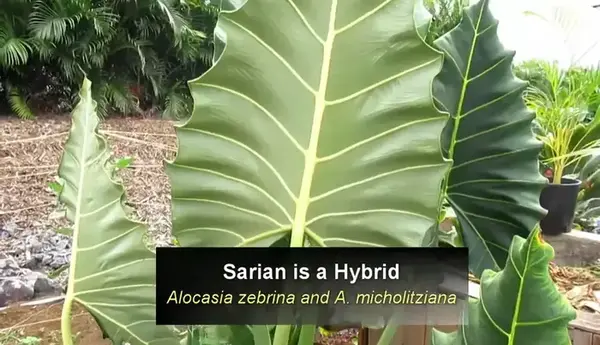
When caring for your plants, you want them to be happy and healthy. Your plants’ health is what makes them grow larger and live longer. Having some knowledge in advance is always preferable before you start. You can find everything concerning the Alocasia Sarian care here! Follow the plant care routine with the proper watering, fertilization, and watering schedule described in our guide.

Lighting | Can Alocasia Sarian take full sun?
Alocasia plants are tropical plants requiring a warm temperature and good light. This plant requires 80 to 90% filtered light. To ensure proper growth, avoid direct sun exposure between 9 am and 5 pm when it’s hottest outside. They do not have to be in direct sunlight, but they can’t be in a shady spot either.
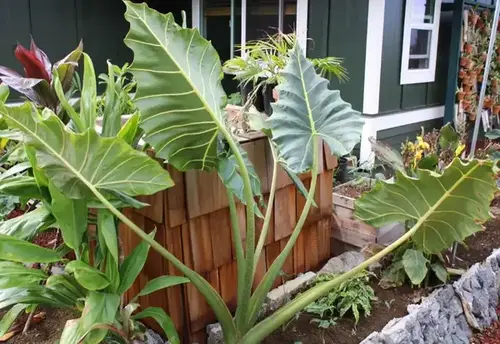
Bright light is recommended for the best growth of this plant, but it will also tolerate some shade. If you live in an area with very little sunlight, you should consider planting this plant indoors, where it will get enough artificial light to thrive.
You may use an artificial light bulb and place it near the plant so that your Alocasia Sarian is not deprived of light. You can also try hanging strings of Christmas lights from the ceiling near your plant for even more light!

Watering
A general rule of thumb is to water Alocasia Sarian twice a week during the summer while watering once a week during the winter. Overwatering can cause root rot or fungal problems in your plant. It is also essential to avoid letting the soil completely dry out because this can lead to dehydration.
It would help if you didn’t try to water your Alocasia Sarian with tap water because the minerals present in tap water can be hard on their roots. Instead, use distilled or rainwater only as they are free of minerals. When watering your Alocasias, make sure you do so thoroughly so that all the soil is moist throughout its root zone.

Humidity and Temperature
The Alocasia Sarian plant will be fine if you keep the humidity above 50 percent. If you keep your plant in a room with low humidity levels, you should provide the plant with adequate humidity levels by using a humidifier to maintain good air humidity around your plant.
You may use other humidity elevating techniques like pebble trays or misting to raise the humidity level. However, in case of misting, please ensure to wipe away the water droplets from the leaves because water staying on leaves can invite a fungal attack.
Plants in tropical climates prefer warm temperatures, and a temperature of around 75-80 degrees Fahrenheit (24 – 27 degrees Celsius) is ideal for this exotic houseplant. If you live in an area cooler than this, you shall bring the plant inside during the winter when it is chilly outside.
In winter, please keep it away from drafts and do not expose it to direct sunlight as this will cause damage.
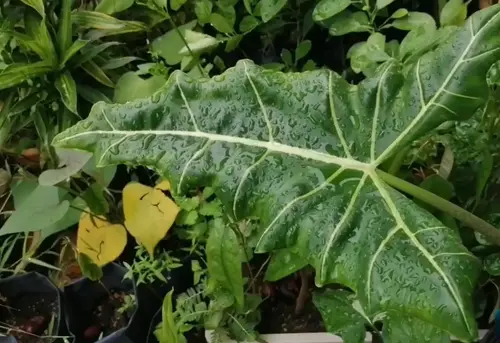
It is recommended that the soil temperature should range from 70 to 80 degrees Fahrenheit. Any lower and your plant might suffer from cold temperatures, while higher temperatures will cause the leaf burn and health to decline.

Fertilizer
If the weather outside is warm, it might be a good idea to fertilize your Alocasia with a water-soluble fertilizer every three weeks. You will also want to make sure that your plant has enough water because too much fertilizer can cause your plant to have excess nutrients, and this can cause problems for the plant.
It would be best if you fertilize your Alocasia Sarian once a month during the spring and summer months when it is actively growing. You should also fertilize your Alocasia Sarian if it has started to flower (it will look like it’s dropping). Do not fertilize your Alocasia Sarian if you see any signs of rot or leaf burning.
When fertilizing Alocasia, use balanced fertilizer containing nitrogen, potassium, and phosphorus. These nutrients are vital for the growth of this plant as they help it grow strong with healthy roots. You can use any organic fertilizer mix or liquid fertilizer solution containing these three elements.

Soil Requirements | What is the best soil for Alocasia Sarian?
The best soil for Alocasia Sarian is a mix of perlite (a type of volcanic rock), peat moss, and/or compost. As well as providing plants with nutrients, these materials ensure good airflow and drainage. A spongy soil with plenty of organic matter will help keep the roots happy while also helping prevent rot from occurring in the potting mix.
If you do not want to use a commercial product, you can make your own by mixing 1 part peat moss with 1 part perlite or vermiculite and 2 parts light soil (such as compost). This mixture will provide enough nutrients for healthy growth and root development without being too heavy on the plant’s roots.
For best growth results, we recommend using a peat-based potting mix. It helps prevent fungal diseases that are common with many types of soil and makes your plants more resistant to pests.

Repotting | When should I repot Alocasia Sarian?
Alocasia Sarian should be repotted every one to two years, depending on how well they grow. If you notice brown leaf edges or if roots are circling the potting soil, it’s time for a new potting soil mix.
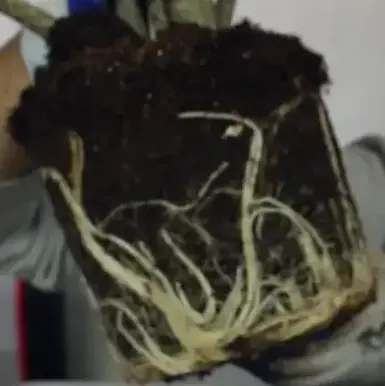
When your plant roots outgrow the container, it is time to repot it. You can do this in four distinct steps:
- First, remove the plant from the pot and shake away any excess soil from the roots.
- Next, put fresh potting soil into your container and place your Alocasia Sarian back into the container. As necessary, you can add more potting soil.
- Finally, add a layer of sphagnum moss around the base of your Alocasia Sarian so that it stays moist while recovering from stress of repotting.

How do you Propagate Alocasia Sarian?
Alocasia Sarian is a perennial plant. Alocasia Sarian can be propagated from seeds, cuttings, and division.
Cutting:
Cuttings will root if placed in well-drained soil that is kept warm (70°F) and moist (at least 10 inches of water per week). After cutting off the top part, you can root the plant’s crown in water. You can also use a knife to make minor cuts on the stem, then place them in the growing medium for two to three weeks until they have roots.
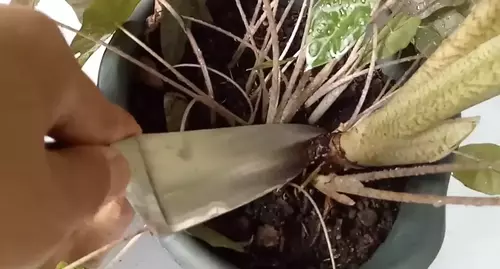
Division:
You may divide your mature Alocasia Sarian into two or more plants through root division. Carefully divide the stems along with roots and leaves and carefully place the newly divided plant into a pot with soil and water. Please cover the plant well with plastic or cling wrap to prevent drying and place it in a humid place until new growth occurs.
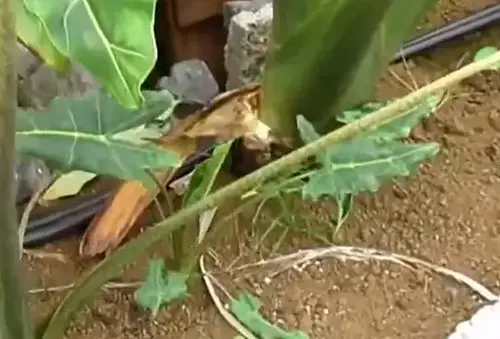

Cleaning and Pruning
Caring for an Alocasia can be pretty straightforward. The leaves are not very delicate, but cleaning the potting mix and removing old leaves regularly is essential. Doing so prevents fungal and insect diseases and infestations.
The best way to care for Alocasia is by keeping it clean and well-trimmed. The root system can be overstressed if the plant is allowed to grow too large, so prune back the plant at least every three months. It will stimulate new shoots’ growth, resulting in new leaves and flowers.
Pruning is done by removing the dead leaves so the plant looks more healthy and gorgeous. The best time to prune Alocasia Sarian is during the early spring, which is at the start of the growing season. Please, always use sterilized and sharp shears or scissors for pruning.
Step by Step Instructions for Pruning:
- Ensure that dead leaves are removed from around the stem and the base of the plant.
- You can use a sharp pair of scissors or small knives to cut away any dead or dying leaves.
- Cut off all damaged or dead branches from your Alocasia Sarian.
- Trim back any overgrown leaves on your Alocasia Sarian

Toxicity
Alocasia is toxic if ingested, even in small amounts. The best thing to do is to keep children away from these plants and pets who might eat them. Eating a leaf or stem may cause stomach cramps or vomiting, but there’s no significant threat unless the child has eaten several leaves or stems. Pets should never be allowed to eat any part of this plant because it can cause vomiting and diarrheas’ within hours of ingestion.

Pests and Diseases
Several pests like mealybugs, scale insects, and nematodes threaten Alocasia. As mentioned earlier, these pests’ growth is caused by external factors such as high humidity levels, poor ventilation, and inadequate soil fertilization.
In addition, some diseases can affect your Alocasia plants, like Alocasia blight which causes yellowing of leaves, leaf spot disease, and root rot. We recommend using a good quality potting mix that has been blended well to drain appropriately when watered.
Additionally, we recommend that the plant be kept in a well-ventilated room that receives plenty of sunlight.
Treatment for Pests
- Mealybugs: It is essential to remove dead or dying leaves from the plant as this will help reduce the population of mealybugs. You may use an insecticide containing azadirachtin (Neem oil) or pyrethrin to control mealybugs.
- Scale insects: Apply insecticidal soap to the leaves and stems, and wipe down with a cotton swab.
- Provide air circulation around your plant by setting it at least four inches away from any walls or furniture. More air circulation around your Alocasia Sarian will improve its health.
- Keep your plant healthy by removing dead leaves regularly and fertilizing once per month with a high-nitrogen fertilizer.
FAQs
Is Alocasia Sarian sun-loving?
Alocasia is a tropical plant requiring filtered sunshine; however, do not put it under direct sunlight. In addition, they should be kept at a humidity level of at least 50%. If you live in a temperate or cool area, you can grow them indoors in pots on a windowsill.
Why are my Alocasia Sarian leaves turning yellow?
The most probable cause of Alocasia Sarian leaves turning yellow is the over-watering. Although the plant is moisture-loving, wet and soggy soil will hurt plant health.
Reduce the water input and place the plant in a brighter location to overcome the problem. Only water the plant once the top two-inch layer of soil has become dry.
Can I put my Alocasia Sarian outside?
Yes, you can put your Alocasia Sarian outdoors if you live in a climate with warm summers and mild winters. If you live in a place where cold weather is typical, it would be best to bring it inside during the winter.
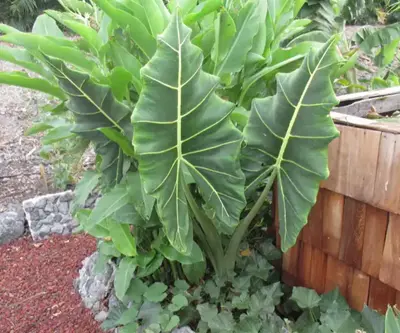
How fast does Alocasia Sarian grow?
Alocasia Sarian is a fast-growing houseplant that can reach up to 5 to 6 feet high over six months. It only takes one year to reach its full size, so you might want to start it early in spring or fall.
Conclusion
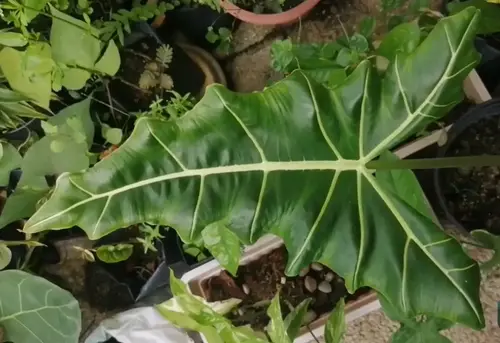
The biggest thing to remember is that Alocasia Sarian, like most plants and all indoor plants, needs proper water, light, air, and soil. It will reward your efforts with luscious leaves and a healthy root system if you can meet the watering, lighting, and airflow requirements. Most importantly, don’t forget to enjoy this exotic indoor houseplant as it amazes you with its large tropical-looking leaves.
Related Posts
Alocasia Calidora | Elephant Ear (Persian Palm) Care
Araceae Family has many gorgeous, attractive-looking, and ornamental indoor plants; Alocasia Calidora is one of them. Alocasia Calidora is a cultivar featuring large ruffled-edged attractive, lush green leaves. Owing to large foliage got the name ‘Calidora’ Elephant ear. These large…
Alocasia Portodora (Upright Elephant Ear) Care Guide
Alocasia Portodora or Portora is an adorable plant with its lush, glossy green tropical leaves, and inviting look. Its alternate name, Upright Elephant Ear plant, refers to its upward-pointing scalloped leaves on thick green stems. Southeast Asian tropical rainforests are…
Alocasia Black Velvet | Alocasia Reginula Care & Propagation Tips
Alocasia family has so many exotic plants, but Alocasia Black Velvet stands out among all because of its stylish appearance ,texture and compact growth habits. It exhibits contrasting silver veins which are prominent over dark leaves with a velvety background. This…
Alocasia Melo | Alocasia Rugosa Care and Propagation Tips
In the Alocasia plant series, our today’s plant is a Jewel Alocasia the stunning Alocasia Melo. There are many exotic plants in the Alocasia genus, but Alocasia Melo differs from all because of its rugged textured leaves. The plant features…
Alocasia Cuprea (Mirror Plant ) | Red Secret Alocasia
The Alocasia Cuprea is a well-loved and breathtaking member of the spectacular Jewel Alocasias- a collection of dwarf Alocasias ideal as ornamental plants for table tops and small indoor spaces. The intriguing glossy and thick oval foliage with a copper-metallic sheen of Alocasia Cuprea makes it…


